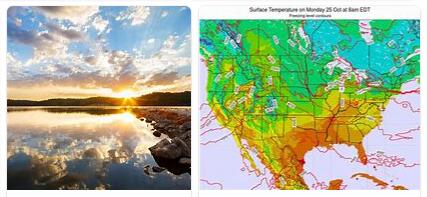With the exception of Alaska, dominated by subpolar climatic characteristics, the USA has an essentially temperate climate, although very varied from area to area (about twenty different climatic types can be distinguished), in relation both to the vastness of the territory, of continental dimensions, and to its conformation, in particular to the meridian and peripheral arrangement of the reliefs, and finally to its opening on three distinct sea fronts. However, the mechanism, so to speak, that determines the climatic conditions is, at the base, relatively simple, since, with the exclusion of the Atlantic and Pacific coastal strips, the vast central area is a kind of “corridor” widely open to the N and to the S to the alternating movements of two masses of air: the continental polar, coming from Canada, and the tropical maritime, expiring from the Gulf of Mexico. They go deep into the interior of the country: so in winter the polar air, cold and dry, it can reach the generally mild southern regions surrounding the Gulf, causing even sudden frosts, while in summer the hot and humid tropical air can reach the Great Lakes area, bringing rain and fog banks. The eastern facade of the country is instead constantly invested by the masses of air of Atlantic origin, which is superimposed, along the southern coasts, by the influence ofSE trade wind; as a result of this there are good rainfall all year round (with maximums in the southern belt) which, although loosening beyond the Appalachians, affect practically the entire eastern belt of the USA, whose isoieta of 1000 mm per year roughly follows the course of the Mississippi. United States is a country located in North America according to EZINERELIGION.COM.
The influence of the air masses of the Pacific is more limited to W, since the western cordillera represent, with their much greater altitude and grandeur, an almost insurmountable obstacle, so that the hinterland is more or less excluded from the oceanic contribution.. The coastal side, on the other hand, is significantly affected in summer by the influence of the anticyclone of the Pacific, which brings clear and dry weather; in winter the northern section is subject to the sea air masses coming from the Aleutian area, the southern one to the tropical sea air masses, so that conditions are determined everywhere suitable for precipitation, less abundant however as one descends towards S. As has been said, the Atlantic climate takes on marked characteristics on the entire eastern facade; however, a distinction must be made between New England and the rest of the region.
New England, located practically N of the Hudson River (41º latitude N, corresponding to the isotherm in January of -1 ºC), in winter it is affected by the continental polar influences, which the Appalachians, not very high, are unable to stop, and which therefore determine a rather harsh winter climate. The polar influences are felt even further to the south and New York itself, which is also located on the sea and at the latitude of Naples, has cold winters, swept by icy northern winds. Even in spring these influences are felt and justify the windy days of March and April. Spring is rather short and summer bursts suddenly; the conditions then reverse and the air masses come mainly from S. Temperatures rise considerably in summer, so much so that July averages of 25 ºC, which drop a few degrees more to the N (22 ºC in Boston). Precipitation is abundant, with over 1000 mm per year, typical of the oceanic climate, and regularly distributed throughout the year; proceeding towards S, however, they tend to concentrate in the autumn season. On the reliefs, the rains are more abundant and annual values are reached even higher than 1500 mm. Different climatic characters are found in the southernmost section of the Appalachian side, presenting rather similarities with those found in Florida and in the entire coastal strip of the Gulf. Temperatures are mitigated, especially in Florida, which is less subject to continental influences: in Miami the averages for January and July go from 19-20 ºC to 27-28 ºC, values that explain the tourist fortunes of this center, while in New Orleans (Louisiana) winter averages drop to 12 ºC. Precipitation is abundant, exceeding 1500 mm per year: it occurs in part also in the summer months, which constitutes a favorable condition for cotton growing, which precisely in the Gulf facade had its first great diffusion, but reduced following the severe soildeterioration. However, the hurricanes, which are formed following the collision between continental cold air masses and tropical warm air masses, frequently hit the whole region, with often disastrous consequences. In the inland plains, the climate takes on continental characteristics, although the temperature variations, typical of this type of climate, are gradually less sensitive from N to S, as are the higher temperatures: in Minneapolis (Minnesota) the average values for January are -6 ºC, those of July 20 ºC, but in Memphis (Tennessee) are respectively 5 ºC and 27 ºC. Precipitation is never abundant, with a characteristic distribution that varies longitudinally, that is, decreasing from E to W, in relation to the progressive weakening of the humid Atlantic influence: to the W of the Mississippi they fall below 1000 mm per year and over the mountains Rocky rarely (for example in the higher altitude areas of the northern ranges) they exceed 500 mm.
The Rocky Mountains region is in fact a climatic area in itself, strongly conditioned both by isolation from maritime influences and by altitude: there is therefore an exasperation of continentality, which is reflected by the thermal values, which record averages winter anywhere below 0 ºC and summer averages around 20 ºC (in Denver in Colorado, located at an altitude of 1609 m, the average values are respectively -2 ºC and 22 ºC). Characteristic of the whole great region is widespread aridity (about 370 mm of rain fall per year in Denver), which is accentuated in the depression basins and generally in the belt of the highlands to the W of the Rocky Mountains, especially in the Great Basin: in Phoenix (Arizona) do not reach 200 mm per year. Here, however, there are again very high temperatures, reaching in the summer in the depression of the Valley of Death even 50 ºC in the shade, one of the highest temperatures in the world. The excesses mostly soften in the western cordillera belt, especially along the coast (strong continentality is instead in the closed California Valley), which constitutes another great climatic region, characterized by relatively uniform temperatures, higher than those of the Atlantic facade with the same latitude (the January isotherms of 4.5 ºC and July of 15.5 ºC run almost parallel to the coast), and by modest temperature variations: in the San Francisco area the temperature difference is even of only 3-4ºC between summer and winter, perhaps the lowest of all Northern America. However, the quantity of precipitation varies greatly, in relation to the particular circulation of the NW oceanic winds that almost exclusively affect the northernmost section, excluding the southern one: Los Angeles falls less than 400 mm of rain per year while in San Francisco, located further north, it exceeds 500 mm. At the northernmost limits of the Coastal Range, in the area of Mount Olympus, there are indeed the maximum rainfall (over 2500 mm) of the United States; the rainfall on the ocean side of the Sierra Nevada is also high, thus allowing the splendid forest cover of this chain. AS of San Francisco, on the other hand, the mild climate (13 ºC in January, 22 ºC in July), the low rainfall, the winter rainfall regime determine those Mediterranean characteristics of the Californian environment that have been a determining factor in the extraordinary economic development and the very strong population of the region.



